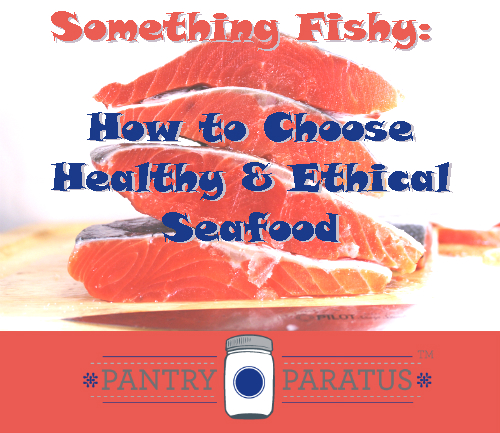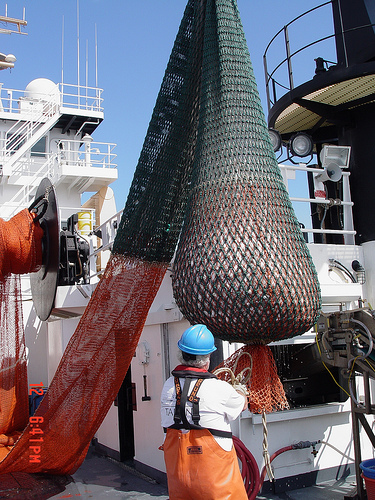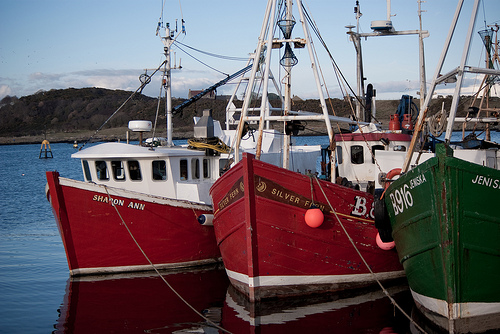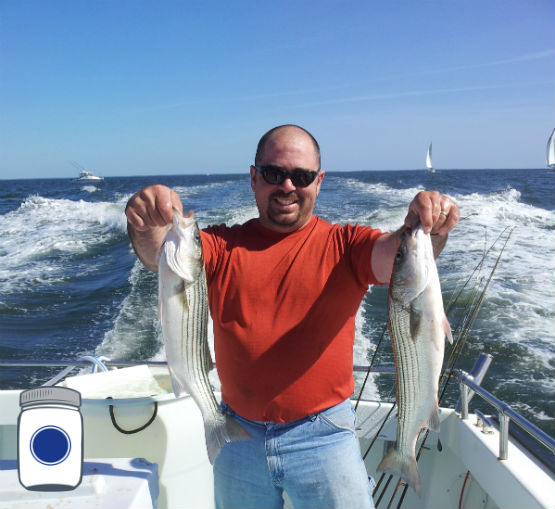Something Fishy In The Tuna Aisle:
How To Choose Healthy & Ethical Seafood

I have been hungry for tuna lately. I put the tuna can down years ago and, apart from one crazy splurge on it in a health food store, I haven’t looked back. You know the reasons: the lack of sustainability, the unknown origins, the unhealthy packaging (BPA-ridden cans), and the mercury. What a list, right? Salmon shares much of the same burden, too.
Yesterday, while kid-less at the grocery store, I impulsively investigated for an ethical can of tuna. I read nearly 20 labels, scrutinized the drastic price differences with no indicator as to why there was such disparity, and I gave up in complete exasperation. Where were the words like “sustainably harvested” or “ethically caught?” Nope. They’re still saying the “dolphin-free” thing on the label, which does nothing to boost my confidence.
Alas, I walked away. Sans Tuna.
Let’s take a brief look at the concerns first and then discuss the alternatives.

Ethically Harvested
Several factors play into whether something was “ethically harvested”…or not. We have been made aware of over-fished regions and populations, especially where a certain fish is preferable, like salmon in the United States or anchovies in Italy. Fishing methods play a part, too. Some cause habitat damage, such as trawling, which scrapes the ocean floor. By-catch or bycatch is the term used for unintentionally caught sea life, such as the turtles caught in shrimp trawling. Sustainable fishery is a complex issue to say the least, but with over 75% of the worlds fishing waters suffering the consequences of past abuse, it is a now-or-never situation if we want to turn the tide (sorry for the pun) and preserve our greatest natural resource for future generations—our water!

American
Our waters are polluted, but there are places that are worse—places that have fewer limits guiding ethical harvesting of the oceans. Food handling is also different in other places, too. To add more confusion, fish labeling is neither common, nor accurate anywhere. For instance, sometimes the name indicates the species and not the location (as in the case of “Atlantic Salmon” that might have been farmed in the Pacific). The good news is that with consumer concern, things are improving. Maybe the grocer behind the counter stares at you blankly when you ask for information now, but given time and our persistence as consumers and we shall see a higher level of knowledge attached to each filet. As consumers, we are not likely to affect the policies of China or any other fishing waters in the world, but we can keep our fish “local,” keep our own waterways clean, and positively affect the labeling and processing found within our own shores.
Mercury Levels
News stories were once plentiful but little is heard these days, should we still be concerned? Oh-My-Yes.

Naturally occurring mercury results from things like volcano eruptions, and little affects our food supply. Two-thirds of mercury affecting Planet Earth is man-made/produced. This is an unnatural problem. The FDA has guidelines regarding acceptable levels of mercury, but they are being sued for it (by Mercury Policy Project) because the FDA places the limit on acceptable exposure at a rate ten times higher than when adverse affects are originally experienced.
I read a report that studied the mercury levels found in women’s hair from nine countries (Global Hair Test, 2013). Note that the United States of America was not one of the tested countries, but we have much to learn from the results. Nearly a quarter of all of the women studied had levels exceeding the EPA guidelines. Japan and Spain had extremely high numbers. This is not a third-world problem, this is not just an American problem, and this is not something we can ignore when shopping the Canned Tuna Aisle of our local store.
This subject alone warrants hours of research. If you want to learn more about the current state of mercury levels in seafood or its affects on health, a scholarly (yet understandable) list of resources have already been compiled for us right here, thanks to the Blue Ocean Institute.
Fish, as we know, is extremely healthy within itself (contamination notwithstanding), and many of us find it delectable. Do not lose hope. After researching this subject, I have found several ways that we can have our fish and eat it too.
Action Step #1: Making this Simple
The Blue Ocean Institute knows how difficult it can be to navigate the plethora of choices that give a deficiency of information, so they give it to you here, where you put the name of a fish into the search bar and a description appears, including the status of mercury levels and ethical harvesting.
Action Step #2: Alternative fish
Alton Brown suggesting an alternative, fresh water fish in place of salmon, because it is delicious and sustainable in harvesting.
Print out this list for your next trip to the grocery store because it is a thorough list of alternatives; match it up with the sales at the seafood counter and take some stress out of the decision-making.
Action Step #3: All Things in Moderation
I am not so good at this. Especially where sushi is concerned. Most research concludes the same, however; if you enjoy “normal” amounts of fish and especially if you are careful to avoid highly contaminated varieties (typically the longer-living fish), then you should be just fine. Remember to heed the warning that young children and pregnant women must avoid the risk of mercury, but enjoy a piece of fish now and again without too much anxiety.

Action Step #4: Support local fisherman—if you have them
You will have fewer food handlers, fewer food miles, and a known origin. Many, many people here in the great state of Montana enjoy fly-fishing for sport but do not necessarily plan to eat their catch. If you know an avid fisherman, offer to trade that homemade blackberry jam for a day’s catch. Learn about your local waterways and their safety, and join the 3% of Americans who catch their own.
We all have to find our balance between health, ethics, and economics. The three seem to be in direct opposition these days. If this article is helping you to navigate these–shall we say–murky waters, let us know! Also tell us ways you have found to eat healthy, ethical seafood, we’d love to hear.
Yours Truly,
Chaya
Looking for a great fish recipe?
Try Buttered Fish in White Wine with Homemade Cranberry Sauce
Fried Striped Bass (or Rockfish)
Would you like to learn how to preserve fish?
This is the classic work on the subject.
If you have a strong stomach, try:
This Fish Stock Recipe (die-hard foodies only)
Proviso:
Nothing in this blog constitutes medical or legal advice. You should consult your own physician before making any dietary changes. Statements in this blog may or may not be congruent with current USDA or FDA guidance.
Resources:
Chefs Collaborative (have developed a free online educational program for chefs called “Green Chef Blue Ocean): http://www.chefscollaborative.org/
Global Hair Test: A Civil Society Pilot Project. Zero Working Mercury Group. October 1, 2013. Retrieved May 4, 2014, from www.zeromercury.org/index.php?option=com_phocadownload&view=file&id=183%3Aassessing-hair-mercury-levels-of-women-of-childbearing-age-in-9-countries-a-civil-society-pilot-project&Itemid=70
Mercury Policy Project. Tuna Surprise: Risk Management Advice for Schools and Parents. August 2012. Access here: http://mercurypolicy.org/wp-content/uploads/2012/09/es915final.pdf
Photo Credits:
The photos bearing the Pantry Paratus logo and/or name are property of Pantry Paratus. Feel free to pin or share in connection to this blog only and please keep proper attribution.
Trawling: NOAA Photo Library via photopin cc
Fishing boats: snappitt photography via photopin cc
mercury poisoning warning sign: Koocheekoo via photopin cc
